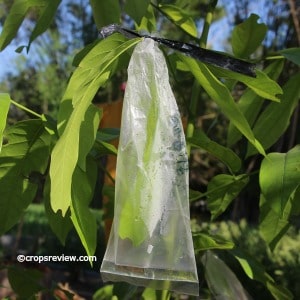There are three types of transpiration, the process in which water is lost from plants in the form of gas or vapor: stomatal, cuticular, and lenticular.
These are briefly described below.
1. Stomatal transpiration
Among the three types of transpiration, this is the most dominant being responsible for most of the water loss in plants.
It accounts for 90-95% of the water transpired from leaves.
As the name suggests, the process involves the participation of the stomata (sing. stoma) or stomates, microscopic pores in the epidermis of the leaves.
Liquid water is first absorbed by the plant through its roots from the soil.
It is then translocated via the xylem tissue in a continuous stream towards the mesophyll cells of the leaves.
Either at the surfaces of the mesophyll cells or of the epidermal cells close to stomata, liquid water is converted to water vapor.
It then escapes through the stomatal pore at the time when it is open to allow entry of CO2 and release of O2.
2. Cuticular Transpiration
This type of transpiration is responsible for the loss of water in plants via the cuticle.
Water vapor directly diffuses through the cuticle on leaves and herbaceous stems and escapes to the atmosphere.

The cuticle is a waxy or resinous layer of cutin, a fatty substance, covering the outside (epidermis) of leaves and other plant parts.
Except for the interruption by stomates and lenticels, the layer is continuous.
The thickness of cuticle varies with species, but xerophytic plants generally have thicker cuticles.
This layer repels water but has some permeability to water vapor.
This type of transpiration accounts for only about 5-10% of the total water loss from leaves (Hopkins 1999).
However, cuticular transpiration rate can be high and stomatal transpiration insignificant under extremely dry conditions due to stomatal closure.
Likewise, in plants having leaves with thin cutin cover, loss of water can be significantly high under conditions that favor high rate of transpiration.
3. Lenticular Transpiration
This type of transpiration is the loss of water from plants as vapor through the lenticels.
The lenticels are tiny openings that protrude from the barks in woody stems and twigs as well as in other plant organs.
Like cuticular transpiration, the escape of water vapor via the lenticels is too low compared to stomatal transpiration.
Similarly, lenticular transpiration tends to become significant in plants subjected to very dry conditions.
Under these conditions, the stomata tend to close thus severely limiting stomatal transpiration.
But with deciduous trees, this type of transpiration may become important during winter in temperate countries.
These trees naturally defoliate at the start of the winter season.
There being no leaves, the magnitude of water loss via lenticels may exceed the rate of water uptake which naturally slows down because low temperature causes water to become more viscous.
This type of transpiration can therefore lead to the desiccation of trees.
Lenticular transpiration also occurs in fruits. It is largely responsible for that shriveled appearance of leftover fruits.
